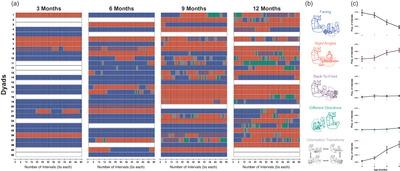Our official English website, www.x-mol.net, welcomes your feedback! (Note: you will need to create a separate account there.)
Dynamics of the dyad: How mothers and infants co-construct interaction spaces during object play
Developmental Science ( IF 4.939 ) Pub Date : 2022-05-18 , DOI: 10.1111/desc.13281 Joshua L Schneider 1 , Emily J Roemer 1 , Jessie B Northrup 2 , Jana M Iverson 1
Developmental Science ( IF 4.939 ) Pub Date : 2022-05-18 , DOI: 10.1111/desc.13281 Joshua L Schneider 1 , Emily J Roemer 1 , Jessie B Northrup 2 , Jana M Iverson 1
Affiliation

|
Studies of dyadic interaction often examine infants’ social exchanges with their caregivers in settings that constrain their physical properties (e.g., infant posture, fixed seating location for infants and adults). Methodological decisions about the physical arrangements of interaction, however, may limit our ability to understand how posture and position shape them. Here we focused on these embodied properties of dyadic interaction in the context of object play. We followed 30 mother–infant dyads across the first year of life (at 3, 6, 9, and 12 months) and observed them during 5 min of play with a standard set of toys. Using an interval-based coding system, we measured developmental change in infant posture, how mothers and infants positioned themselves relative to one another, and how they populated interaction spaces with objects. Results showed that mother–infant dyads co-constructed interaction spaces and that the contributions of each partner changed across development. Dyads progressively adopted a broader spatial co-orientation during play (e.g., positioned at right angles) across the first year. Moreover, advances in infants’ postural skills, particularly increases in the use of independent sitting in real time, uniquely predicted change in dyadic co-orientation and infants’ actions with objects, independent of age. Taken together, we show that the embodied properties of dyadic object play help determine how interactions are physically organized and unfold, both in real time and across the first year of life.
中文翻译:

二元组的动态:母亲和婴儿如何在玩物体时共同构建互动空间
对二元互动的研究通常考察婴儿在限制其身体特性(例如,婴儿姿势、婴儿和成人的固定座位位置)的环境中与其照顾者的社会交流。然而,关于交互的物理安排的方法论决定可能会限制我们理解姿势和位置如何塑造它们的能力。在这里,我们关注对象游戏背景下二元交互的这些具体属性。我们在生命的第一年(3、6、9 和 12 个月)跟踪了 30 对母婴对,并观察了他们玩一套标准玩具的 5 分钟。使用基于间隔的编码系统,我们测量了婴儿姿势的发育变化、母亲和婴儿如何相对于彼此定位,以及他们如何使用物体填充交互空间。结果表明,母婴二人共同构建了互动空间,并且每个伙伴的贡献在整个发展过程中都发生了变化。Dyads 在第一年的游戏过程中逐渐采用了更广泛的空间共同定位(例如,以直角定位)。此外,婴儿姿势技能的进步,特别是实时独立坐姿使用的增加,独特地预测了二元共同定向和婴儿与物体的行为的变化,与年龄无关。综上所述,我们表明,二元对象游戏的具身属性有助于确定互动的物理组织和展开方式,无论是实时的还是在生命的第一年。Dyads 在第一年的游戏过程中逐渐采用了更广泛的空间共同定位(例如,以直角定位)。此外,婴儿姿势技能的进步,特别是实时独立坐姿使用的增加,独特地预测了二元共同定向和婴儿与物体的行为的变化,与年龄无关。综上所述,我们表明,二元对象游戏的具身属性有助于确定互动的物理组织和展开方式,无论是实时的还是在生命的第一年。Dyads 在第一年的游戏过程中逐渐采用了更广泛的空间共同定位(例如,以直角定位)。此外,婴儿姿势技能的进步,特别是实时独立坐姿使用的增加,独特地预测了二元共同定向和婴儿与物体的行为的变化,与年龄无关。综上所述,我们表明,二元对象游戏的具身属性有助于确定互动的物理组织和展开方式,无论是实时的还是在生命的第一年。独立于年龄。综上所述,我们表明,二元对象游戏的具身属性有助于确定互动的物理组织和展开方式,无论是实时的还是在生命的第一年。独立于年龄。综上所述,我们表明,二元对象游戏的具身属性有助于确定互动的物理组织和展开方式,无论是实时的还是在生命的第一年。
更新日期:2022-05-18
中文翻译:

二元组的动态:母亲和婴儿如何在玩物体时共同构建互动空间
对二元互动的研究通常考察婴儿在限制其身体特性(例如,婴儿姿势、婴儿和成人的固定座位位置)的环境中与其照顾者的社会交流。然而,关于交互的物理安排的方法论决定可能会限制我们理解姿势和位置如何塑造它们的能力。在这里,我们关注对象游戏背景下二元交互的这些具体属性。我们在生命的第一年(3、6、9 和 12 个月)跟踪了 30 对母婴对,并观察了他们玩一套标准玩具的 5 分钟。使用基于间隔的编码系统,我们测量了婴儿姿势的发育变化、母亲和婴儿如何相对于彼此定位,以及他们如何使用物体填充交互空间。结果表明,母婴二人共同构建了互动空间,并且每个伙伴的贡献在整个发展过程中都发生了变化。Dyads 在第一年的游戏过程中逐渐采用了更广泛的空间共同定位(例如,以直角定位)。此外,婴儿姿势技能的进步,特别是实时独立坐姿使用的增加,独特地预测了二元共同定向和婴儿与物体的行为的变化,与年龄无关。综上所述,我们表明,二元对象游戏的具身属性有助于确定互动的物理组织和展开方式,无论是实时的还是在生命的第一年。Dyads 在第一年的游戏过程中逐渐采用了更广泛的空间共同定位(例如,以直角定位)。此外,婴儿姿势技能的进步,特别是实时独立坐姿使用的增加,独特地预测了二元共同定向和婴儿与物体的行为的变化,与年龄无关。综上所述,我们表明,二元对象游戏的具身属性有助于确定互动的物理组织和展开方式,无论是实时的还是在生命的第一年。Dyads 在第一年的游戏过程中逐渐采用了更广泛的空间共同定位(例如,以直角定位)。此外,婴儿姿势技能的进步,特别是实时独立坐姿使用的增加,独特地预测了二元共同定向和婴儿与物体的行为的变化,与年龄无关。综上所述,我们表明,二元对象游戏的具身属性有助于确定互动的物理组织和展开方式,无论是实时的还是在生命的第一年。独立于年龄。综上所述,我们表明,二元对象游戏的具身属性有助于确定互动的物理组织和展开方式,无论是实时的还是在生命的第一年。独立于年龄。综上所述,我们表明,二元对象游戏的具身属性有助于确定互动的物理组织和展开方式,无论是实时的还是在生命的第一年。


























 京公网安备 11010802027423号
京公网安备 11010802027423号